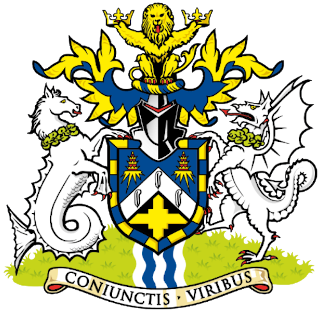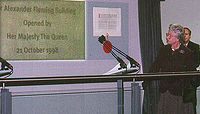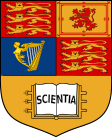
Imperial College London (Imperial) is a public research university in London, England. Its history began with Queen Victoria's husband, Prince Albert, who envisioned a cultural area in South Kensington that included museums, colleges, and the Royal Albert Hall. In 1907, these colleges – the Royal College of Science, the Royal School of Mines, and the City and Guilds of London Institute – merged to form the Imperial College of Science and Technology.

GKT School of Medical Education is the medical school of King's College London. The school has campuses at three institutions, Guy's Hospital (Southwark), King's College Hospital and St Thomas' Hospital (Lambeth) in London – with the initial of each hospital making up the acronymous name of the school. The school in its current guise was formed following a merger with the United Medical and Dental Schools of Guy's and St Thomas' Hospitals on 1 August 1998. As of 2023, the medical school is ranked 5th best in the UK for clinical medicine by U.S. News & World Report, and 10th best worldwide by Times Higher Education.

King's College London is a public research university located in London, England. King's was established by royal charter in 1829 under the patronage of King George IV and the Duke of Wellington. In 1836, King's became one of the two founding colleges of the University of London. It is one of the oldest university-level institutions in England. In the late 20th century, King's grew through a series of mergers, including with Queen Elizabeth College and Chelsea College of Science and Technology, the Institute of Psychiatry, the United Medical and Dental Schools of Guy's and St Thomas' Hospitals and the Florence Nightingale School of Nursing and Midwifery.

The University of Sheffield is a public research university in Sheffield, South Yorkshire, England. Its history traces back to the foundation of Sheffield Medical School in 1828, Firth College in 1879 and Sheffield Technical School in 1884. University College of Sheffield was subsequently formed by the amalgamation of the three institutions in 1897 and was granted a royal charter as University of Sheffield in 1905 by King Edward VII.

Queen Mary University of London is a public research university in Mile End, East London, England. It is a member institution of the federal University of London.

The London School of Hygiene & Tropical Medicine (LSHTM) is a public research university in Bloomsbury, central London, and a member institution of the University of London that specialises in public health and tropical medicine. The institution was founded in 1899 by Sir Patrick Manson, after a donation from the Indian Parsi philanthropist B. D. Petit.

St Mary's Hospital is an NHS district general hospital in Paddington, in the City of Westminster, London, founded in 1845. Since the UK's first academic health science centre was created in 2008, it has been operated by Imperial College Healthcare NHS Trust, which also operates Charing Cross Hospital, Hammersmith Hospital, Queen Charlotte's and Chelsea Hospital and the Western Eye Hospital.
The University of Maryland School of Medicine, located in Baltimore City, Maryland, U.S., is the medical school of the University of Maryland, Baltimore and is affiliated with the University of Maryland Medical Center and Medical System. Established in 1807 as the College of Medicine of Maryland, it is the first public and the fifth oldest medical school in the United States. UMB SOM's campus includes Davidge Hall, which was built in 1812, and is the oldest building in continuous use for medical education in the Northern Hemisphere.
Imperial College School of Medicine (ICSM) is the undergraduate medical school of Imperial College London in England and one of the United Hospitals. It is part of the college's Faculty of Medicine and was formed by the merger of several historic medical schools. Its core campuses are located at South Kensington, St Mary's, Charing Cross, Hammersmith and Chelsea and Westminster. The school ranked 4th in the world for medicine in the 2024 Times Higher Education World University Rankings.

Aga Khan University is a not-for-profit institution and an agency of the Aga Khan Development Network. It was founded in 1983 as Pakistan's first private university. Starting in 2000, the university expanded to Kenya, Tanzania, Uganda, the United Kingdom and Afghanistan.

Hammersmith Hospital, formerly the Military Orthopaedic Hospital, and later the Special Surgical Hospital, is a major teaching hospital in White City, West London. It is part of Imperial College Healthcare NHS Trust in the London Borough of Hammersmith and Fulham, and is associated with the Imperial College Faculty of Medicine. Confusingly the hospital is not in Hammersmith but is located in White City adjacent to Wormwood Scrubs and East Acton.

Ara Warkes Darzi, Baron Darzi of Denham is an Armenian-British surgeon, academic, and politician.

Chelsea and Westminster Hospital is a 430-bed teaching hospital located in Chelsea, London. The hospital has a rich history in that it serves as the new site for the Westminster Hospital. It is operated by Chelsea and Westminster Hospital NHS Foundation Trust, and became a member of Imperial College Academic Health Science Centre in July 2020. The hospital is the central part of Imperial College London Chelsea and Westminster Campus, and plays an integral role in teaching students and conducting medical research at Imperial College London.

Queen Charlotte's and Chelsea Hospital is one of the oldest maternity hospitals in Europe, founded in 1739 in London. Until October 2000, it occupied a site at 339–351 Goldhawk Road, Hammersmith, but is now located between East Acton and White City, adjacent to the Hammersmith Hospital. It is managed by the Imperial College Healthcare NHS Trust.
Imperial College Healthcare NHS Trust is an NHS trust based in London, England. It is one of the largest NHS trusts in England and together with Imperial College London forms an academic health science centre.
Sir Gordon William Duff, is a British medical scientist and academic. He was principal of St Hilda's College, Oxford, from 2014 to 2021. He was Lord Florey Professor of Molecular Medicine at the University of Sheffield from 1991 to 2014.
Peter John Morland Openshaw, is a British clinician and scientist specialising in lung immunology, particularly defence against viral infections. He trained in lung diseases and undertook a PhD in immunology before establishing a laboratory at St Mary's Hospital Medical School. He created the academic department of Respiratory Medicine and the Centre for Respiratory Infection at Imperial College and was elected President of the British Society for Immunology in 2014.

The history of Imperial College London can be traced back to the founding of the Royal College of Chemistry in 1845 in London, with some ancestral medical schools dating back to 1823. The college was formed in 1907 out of the royal colleges in South Kensington, and throughout the 20th century became central to the national strategy for technical education and research. It existed for most of its life as part of the University of London, only becoming independent in 2007.
Azeem Majeed is a Professor and Head of the Department of Primary Care & Public Health at Imperial College, London, as well as a general practitioner in South London and a consultant in public health. In the most recent UK University Research Excellence Framework results, Imperial College London was the highest ranked university in the UK for the quality of research in the “Public Health, Health Services and Primary Care” unit of assessment.
The Institute of Global Health Innovation is one of Imperial College London’s global challenge Institutes. Established in 2010, its mission is to improve global health and care through evidence-based innovation. The Institute’s work aims to support the identification, development and implementation of healthcare innovation, with the goal of sustainably reducing inequalities in global health.
















